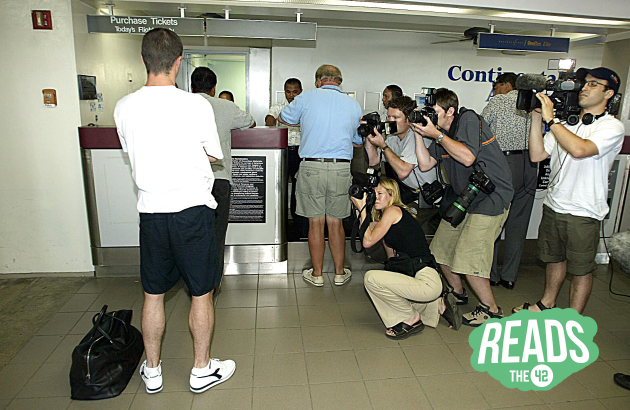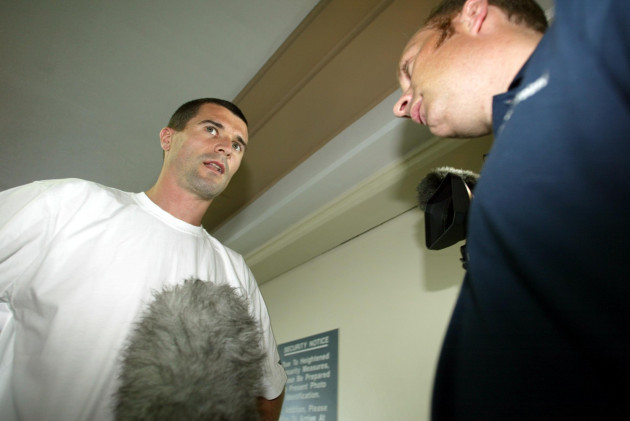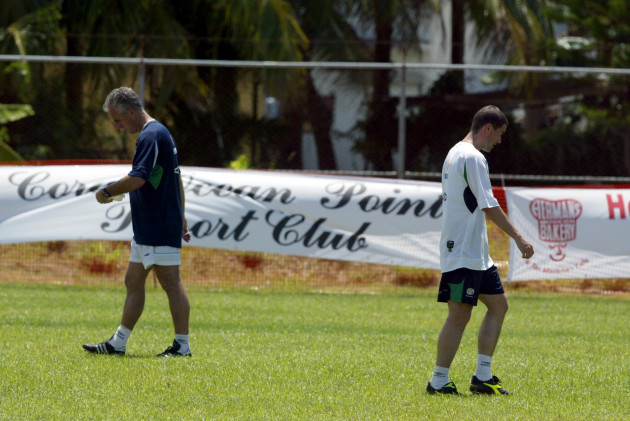A BBC REPORTER is standing in the airport on the island of Saipan, making the most important deal of his career with a fellow journalist. He’s holding a tape in his hand that absolutely must get to Belfast, and the journalist can assist with that by bringing it with him on his flight to Tokyo.
In Saipan, the heat is fierce and puts you in a sweat the minute you open the door. The hottest place he’s ever been in. Gambling with the trust of another reporter in this temperature isn’t helped by the fact that they’re negotiating near an outdoor check-in.
The BBC has an office in Tokyo, and if the tape can be brought that far, the people there can hook up the material to their colleagues back at base. It’s the only way to do their job in 2002 as there are no TV editing facilities on the island, which is based in the western Pacific Ocean. The mobile phone age has barely stirred into life either. There’s certainly none of them on the island. It’s working with pestle and mortar by today’s standards of instant telecommunications.
The journalist agrees to help out, but not without getting his own back scratched in return.
“What did he say?” he inquires.
“If I tell you, will you take my tape?” comes the reply.
They have a deal. The reporter can use the quotes, and the BBC will get a carefully delivered tape containing a brief but timeless interview with Roy Keane after being sent home on the eve of the World Cup.
This is precious cargo and it wasn’t easy to get.
- See sport differently with The42 Membership and get closer to the stories that matter with exclusive analysis, insight and debate. Click here to find out more>
“I went up and asked him [Keane] loads of questions and he never spoke or made eye contact,” BBC’s Stephen Watson remembers. This was his first major sports event to cover for BBC after joining the broadcaster joined from UTV in 2000.
“And we actually went away. He was still standing in the queue, so we went back to him again to try for a second time. So, what you actually see [on the footage] is actually the second time we went to speak to him.
“By the time the tape got to Tokyo, my pictures were used, and literally a few hours later, there was footage of Roy Keane walking his dog in Manchester.
“There you have the biggest story of your life and you’ve just handed it to someone on a plane.”
***
The journalists gathered outside the hotel were sure that Roy Keane was coming out the front door.
The pre-existing tension between the Republic of Ireland captain and manager Mick McCarthy had simply reached a pitch, and one of them had to go. News of the war in Saipan has caused uproar at home and divided the country. Everyone is picking a side. Team Roy or Team Mick. The Man United star and arguably the best midfielder in the world dishonourably discharged from the national side.
In a conversation with his father, Watson would later hear of people protesting and laying wreaths outside the offices of the FAI, such was the impact of Keane’s loss to the Ireland team.
Much of the travelling media have already left the island, after hearing of Keane’s exile. Onto Japan and South Korea where the tournament is being staged, and where Ireland would eventually fall to Spain after penalties. Watson and his cameraman, who he knew as Pooky, are among the few journalists and photographers who are staying on in the hope of catching Keane for a quick word before his departure.
All bets are on the front door.
“We just made a mad decision,” says Watson taking up the story. “If Roy Keane is still on this island, we’ve got to try and speak to him. So we stayed.
“I think there was five or six of us all staying together. We were just waiting in the hotel to see if we could grab him before he left. They were loading all of his bags into a very fancy limo-style car and we thought he was coming out the front.
“But that was just a decoy and he was actually leaving out the back to try and get to the airport without anybody tracking him. One of the porters who was probably given a few quid by one of the photographers said, ‘Oh, Mr Keane is leaving from the back door.’
“So, we all got into a people-carrier and made our way to the airport. And literally about a mile before the airport, we passed him in the van.”
On the way, Pooky has bad news for Watson. The camera, which is a rented piece of equipment, has stopped working due to the humidity. All Watson can do in response is stress the rarity of this opportunity.
“I remember saying to him, ‘Can you please do whatever you can to get that camera working?’ As long as you live, you will not work on as big a story as this. And he got it working.
“But it was strange because Roy was on his own at the airport. There was nobody with him, he was just on his own. He didn’t have anybody and nobody knew who he was so he just had to stand in the queue on his own.
“That’s why we were able to go back and ask him more questions because he had to stand in the queue for so long.”
***
Lots of ghost stories have followed the legacy of Saipan. Scathing interviews with Roy Keane, and Mick McCarthy holding a copy of the Irish Times containing one of those interviews at a testy team meeting – everyone who was there has a different recollection of what happened. For Keane’s part, issues relating to equipment and the standard of the training pitch formed the bulk of his frustrations.
Watson respected McCarthy’s convictions in sending home the team captain, but shortly after arriving at Saipan, he could understand Keane’s misgivings about the place.
“It was a really strange kind of place, which seemed to be quite ill-prepared for them arriving.
“I do remember them turning up at training on the first day and, from memory, there were no balls so they were just running around.
“I actually did a story which never saw the light of day because the whole Roy Keane thing happened. We did a story about how Saipan prepared for to have the Republic of Ireland team there and how they ended up in Saipan.
“The training pitch wasn’t great and they said that when they dug up the ground, they found a tank underneath from the World War but I never ended up getting that story done because Roy Keane ended up getting sent home.”
Watson is joined by two other TV stations during his time in Saipan. To combat the primitive working conditions of the time, they use satellite phones to communicate with their networks and have someone fly in a couple of times per week to collect all of their tapes and bring them to Tokyo where they can be sent on to their respective companies at home.
Difficult to manage in normal circumstances, but even more so while trying to cover an ever-changing story. Each day bringing another twist of events. Keane threatens to quit the team. Keane is persuaded to reconsider. Keane stays. Another flare-up at a team meeting. Keane goes. Keane is coming back. Keane stays away for good.
That’s a lot of tapes.
“You couldn’t send any television pictures the way you do now, and just upload them on WeTransfer,” says Watson. “We were very limited in what we could shoot as well.”
A barbecue is organised to bring the media and members of the Ireland squad together for a casual social evening. An ice-breaker to ease everyone into the tournament where they will spend weeks together in tight company. That’s where Watson first senses an atmosphere at the pre-World Cup training base.
“I do remember that was a bit strained. It was just a bit awkward. A lot of the backroom team were there wearing the garlands around their neck that you would wear in that part of the world. It was like a hula party.
“I only spoke to Roy very briefly at that, just to say hello and introduce myself. But to be honest, he looked like a man who didn’t really want to be there. He was courteous and pleasant, but he did look like he didn’t want to be at a party. He probably couldn’t understand why we were doing this.
“After that, a lot of the media went to a bar with a lot of the players for a few beers and games of darts, which was great. I had a good, long chat with Steve Staunton that time and he was joking because there was a Steve Watson who played for Newcastle.
“But at that time, we had absolutely no idea about what was going to happen. But it was a bit strained. A lot of the players looked like they didn’t want to be there.”
***
Watson reaches Japan to prepare for the actual event, and heads out for dinner and drinks with a few other journalists to draw breath and decompress after the Keane vs McCarthy conflict. But even after Keane has been removed, his presence still lingers. The press receive word from home that forces them to put their drinks down and get back on the job.
“Roy Keane’s coming back!” Watson recalls what they heard.
“So, we ended up having to cut that short and head back to the rooftop of our hotel and do a lot of live interviews, and then that kind of all went away and he didn’t come back.
“The rest of the tournament was really fun and a really memorable time. I always wondered though if they had had him at the last game [against Spain], would that have been the difference. You just never know.”
***
It’s the 20th anniversary since that infamous week in Irish sport, culminating with Keane’s dramatic exit on 24 May. In the passing years, both McCarthy and Keane have circled back into the Republic of Ireland fold; McCarthy returning as manager and Keane serving as assistant manager to Martin O’Neill. The pair have never reconciled their differences.
Watson has encountered some of the journalists who waited for Keane at the Saipan airport in that time too. An exchange of glances is all that’s needed to send them back 20 years to that extraordinary time.
Watson has crossed paths with the two main characters in that time too, but has only spoken to McCarthy.
“Mick has always been great,” he says. “I’ve tried to interviewed Roy a couple of times and no. I remember seeing him at an Ireland-England rugby match and I tried to get an interview and he didn’t want to speak. I very much doubt he remembers that it was me who was asking the questions in Saipan.
“I would love to do an interview with him and reflect on it all.”
Away from sport, Watson underwent a second kidney transplant in late 2019 having had his first one in 1989, when his father was the donor for his 18-year-old son. Watson discovered as a teenager that his kidneys had not formed properly at birth, which eventually resulted in the need for a transplant.
While he was waiting for a kidney the second time around, Watson went for four dialysis sessions per week, all of which ran for five hours.
“A lot of people decide not to work,” Watson explains, “but I wanted to try and prove that you can work while having dialysis and I did. I went in for my dialysis at 6.30 in the morning and got out at 12 and went working. I had it at the Masters Golf, the Isle of Man TT, the Ryder Cup in France and I was able to cover events away from home and still have my dialysis.
“Belfast is a world leader in kidney transplantation and the Belfast City hospital do more live kidney transplants per head of population than anywhere else in the world, so I’m very fortunate to live here with a kidney problem. There’s no better place in the world to live with a kidney disease.
“I’m not on dialysis anymore, it’s great.”
Watson didn’t realise that this was the week of Saipan’s 20th anniversary, but found himself reliving some of the memories while out for a round of golf with some friends during the week. He has one framed photo of his airport exchange with Roy Keane in his office.
“Clear conscience… happy to be going home,” are the iconic words that Watson managed to tempt from Keane on that day after his second attempt at raising the microphone. It’s a short clip, but is one of the enduring images of the entire saga. A Reeling In The Years moment.
“To be involved with a story like that was pretty special,” says a proud Watson. “Things like that don’t come along very often and people still talk to me about it. It’s still probably the biggest story I’ve ever been involved in because it was of such a global nature. You’re at one of the world’s biggest sporting events and you’ve been able to capture the story that everybody wants. It did feel really special at the time and it was really fun.”
See sport differently with The42 Membership and get closer to the stories that matter with exclusive analysis, insight and debate. Click here to find out more>



